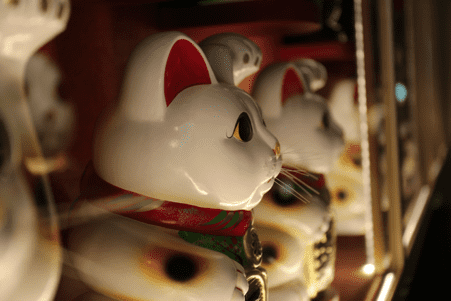Quick guide to Japanese good luck charms
We’re here to delight with popular good luck charms from Japan and the sorts of blessings they serve.
Coming from a previous article we did about ways to say “good luck” in different languages.
Maneki-neko
The white ceramic cat with its raised paw you see in our header photo is the maneki-neko (招き猫), “beckoning cat”. That’s what the raised paw is doing, and depending on the product manufacturer, a number of these figures do have a motorized paw beckoning at you. If you’ve been to local stores in Asian cities — Japan, of course, but also Hong Kong, Singapore and Malaysia — you might have caught sight of a cat sitting next to the cash register, beckoning with its right paw. These cats are thought to bring wealth. Alternatively, a maneki-neko with a raised left paw brings blessing to relationships. You can see why shop-owners would favor the right-paw cat over the left-paw cat.
The maneki-neko is often white in color, with black-gold spots like a calico cat. They usually hold a large golden coin in front of them, inscribed with characters for wealth.
Omamori
お守り means amulet, referring to small and colorful little packet charms that can be bought from Shinto temples. Each temple boasts its own patterns and designs, with the type of the omamori on one side, and the temple’s name on the other. The inside of the amulet contains the blessing and should never be opened, or else the blessing would escape!These amulets are usually secured with a white knot, while the rest of the strap allows it to be tied to bag straps as a keychain.
Here are a few common omamori types and their purposes for your consideration:
Ema boards
絵馬, for “picture horse”, are small little wooden plaques that can be found in most Shinto temples. In the past, horses were treasured gifts that worshippers hoping for a blessing could choose to donate to the shrine. However, as they were so expensive, an alternate practice of donating horses made of other materials like clay and wood arose. Thus, the ema was born. Nowadays, while the shape of the board remains the same, shrines have varied up the design by printing other images — such as the zodiac animal of the year, or even anime characters — on the side. However, the traditions and properties of the ema remains the same. Worshippers with a wish in mind inscribe it on the plaque and tie it up on the special wall designated for ema boards.
Omikuji
Literally meaning “fortune lottery”, おみくじ are tiny slips of paper you draw by random — either shaking a number plate out of a box, by pulling one out of a box, or by vending machine. Each slip contains information as to whether or not you have good fortune “吉” (kichi) or bad fortune “凶” (kyou). It’s customary to tie bad fortunes onto the branches of a pine tree such that the bad luck will not stick to you; conversely, good fortune slips should be kept close to your person, such as keeping them in a wallet.
For more information on Japanese cultural practices, sign up for one of our language courses now!

